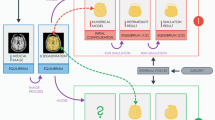Abstract
In 3D deformable modeling approaches based on FEM, inverted tetrahedral elements can cause undesired visual artifacts and the breakdown of the simulation. As inversion can never be avoided and sometimes is even the correct behavior of elements, there is a strong need for stable inversion handling. In this paper, we propose a novel method to resolve inverted elements which is motivated by previous work of Irving et al. [6]. In combination with an efficient handling of degenerated elements, our approach yields a stable simulation of arbitrary deformations. Although we focus on the corotational formulation of linear FEM, the method can be implemented within arbitrary constitutive models.
Similar content being viewed by others
Explore related subjects
Discover the latest articles, news and stories from top researchers in related subjects.References
Chen, D., Zeltzer, D.: Pump it up: Computer animation of a biomechanically based model of muscle using the finite element method. In: Proceedings of ACM SIGGRAPH, pp. 89–98. ACM, New York (1992)
Debunne, G., Desbrun, M., Cani, M.P., Barr, A.H.: Dynamic real-time deformations using space & time adaptive sampling. In: Proc. 28th Annual Conference on Computer Graphics and Interactive Techniques, ACM SIGGRAPH, pp. 31–36. ACM, New York (2001)
Escobar, J.M., Rodríguez, E., Montenegro, R., Montenero, G., González-Yuste, J.M.: Simultaneous untangling and smoothing of tetrahedral meshes. Comput. Methods Appl. Mech. Eng. 192, 2775–2787 (2003)
Espinosa, H., Zavattieri, P., Emore, G.: Adaptive FEM computation of geometric and material nonlinearities with application to brittle fracture. Mech. Mater. 29, 275–305 (1998)
Hauth, M., Strasser, W.: Corotational simulation of deformable solids. J. WSCG 12, 137–145 (2004)
Irving, G., Teran, J., Fedkiw, R.: Invertible finite elements for robust simulation of large deformation. In: Proceedings of the 2004 ACM SIGGRAPH/Eurographics Symposium on Computer Animation, pp. 131–140. Eurographics Association, Aire-la-Ville, Switzerland (2004)
Kanatani, K.: Analysis of 3-D rotation fitting. IEEE Trans. Pattern Anal. Mach. Intell. 16, 543–549 (1994)
Müller, M., Dorsey, J., McMillan, L., Jagnow, R., Cutler, B.: Stable real time deformations. In: Proceedings of ACM SIGGRAPH Symposium on Computer Animation, pp. 49–54. ACM, New York (2002)
Müller, M., Gross, M.: Interactive virtual materials. In: Proceedings of Graphics Interface, pp. 239–246. Canadian Human-Computer Communication Society, Waterloo, Ontario, Canada (2004)
Müller, M., Heidelberger, B., Teschner, M., Gross, M.: Meshless deformations based on shape matching. In: Proceedings of ACM SIGGRAPH International Conference on Computer Graphics and Interactive Techniques, pp. 471–478. ACM, New York (2005)
O’Brian, J., Bargteil, A., Hodgins, J.: Graphical modeling and animation of ductile fracture. ACM Trans. Graph. (Proceedings of ACM SIGGRAPH) 21, 291–294 (2002)
O’Brian, J., Hodgins, J.: Graphical modeling and animation of brittle fracture. In: Proceedings of ACM SIGGRAPH, vol. 18, pp. 137–146. ACM Press/Addison-Wesley Publishing Co. (1999)
Picinbono, G., Delingette, H., Ayache, N.: Non-linear and anisotropic elastic soft tissue models for medical simulation. In: IEEE Int. Conf. Robotics and Automation, pp. 1370–1375. IEEE (2001)
Terzopoulos, D., Platt, J., Barr, A., Fleischer, K.: Elastically deformable models. In: Proceedings of ACM SIGGRAPH, pp. 205–214. ACM, New York (1987)
Teschner, M., Heidelberger, B., Müller, M., Gross, M.: A versatile and robust model for geometrically complex deformable solids. In: Proc. Computer Graphics International, pp. 312–319. IEEE Computer Society, Washington, DC (2004)
Vachal, P., Garimella, R.V., Shashkov, M.J.: Untangling of 2D meshes in ALE simulations. J. Comput. Phys. 196, 627–644 (2004)
Zieliński, P., Zio̧tak, K.: The polar decomposition – properties, applications and algorithms. Mat. Stosow. 38, 23–40 (1995)
Author information
Authors and Affiliations
Corresponding author
Rights and permissions
About this article
Cite this article
Schmedding, R., Teschner, M. Inversion handling for stable deformable modeling. Visual Comput 24, 625–633 (2008). https://doi.org/10.1007/s00371-008-0243-y
Published:
Issue Date:
DOI: https://doi.org/10.1007/s00371-008-0243-y




